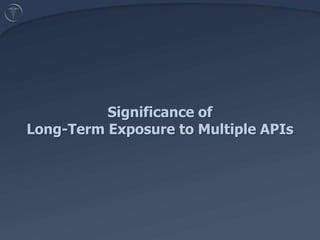
2.2. Significance of Long-Term Exposure to Multiple APIs (Ruhoy)
- 1. Significance of Long-Term Exposure to Multiple APIs
- 2. Toxicity of Complex Environmental Mixtures:Major Unanswered Questions ? What is the significance of long-term exposure to multiple APIs each presentat levels below known effect levels?
- 3. The Potential forHuman Health Effects Human exposure to APIs recycled from the environment via potable water is limited. Extremely low concentrations (< 10 ng/L) Many APIs insource waters are removed by treatment Toxicological research restricted to in vitro studies and very limited epidemiological data. Concern focused primarily on vulnerable windows of exposure (e.g., fetal exposure) or to contraindicated APIs. Comparisons made with therapeutic levels are irrelevant (different mechanisms of action at ultra-low levels)
- 4. Human Exposure Function of Identities, quantities, & geographic distribution of APIs ADME Environmental transport Environmental fate Exposure routes
- 5. Key Questions Despite the years of debate and discussion, surprisingly no single, comprehensive resource exists that examines and distills what is known (and what further needs to be known) and that provides a synoptic overview of this multi-faceted topic. Key questions Where do leftover drugs accumulate in society? What causes their accumulation? What are the routes and methods used in their disposal? What portion of drug residues in the environment originate from disposal? What are the risks for humans, domestic animals, and wildlife? How can the accumulation of excess medications by consumers be minimized or eliminated? How can these unwanted drugs be best disposed? Are there potential benefits beyond reduced environmental impact by minimizing the incidence of leftover medications?
- 6. Tying Effects to Exposure Considerable evidence exists on the potential for low-dose effects from cellular and whole-organisms controlled exposures at levels lower than the nm or even pm ranges. But identifying and trying adverse consequences in non-target organisms exposed in real-world settings has met with limited success. To what extent do morphological abnormalities in aquatic organisms result from trace-level anthropogenic chemical exposures versus natural incidence? Similarly: to what extent can biological effects be maskedor concealed by ambient incident?
- 7. Tying Effects to Exposure Subtle effects, such as behavioral or immunological, can result from chronic low-level exposures from single or multiple PPCPs, each present below purported no-observed effects levels Such receptors sometimes involve receptors that differ than those in humans Mechanisms of actions (MOAs) can change as the exposure levels are reduced, and dose-response linearity can vary greatly among chemicals Furthermore, actual MOAs are frequently unknown and individual APIs can be promiscuous in their biochemical actions
- 9. Proper disposal is greatly complicated by the conflict between the need to protect public safety (e.g., from drug diversion) and the need to minimize environmental exposure* DaughtonCG and Ruhoy IS. "Environmental Footprint of Pharmaceuticals: The Significance of Factors Beyond Direct Excretion to Sewers," Environmental Toxicology & Chemistry 2009, 28(12):2495-2521; doi:10.1897/08-382.1; available: http://www3.interscience.wiley.com/cgi-bin/fulltext/123234136/PDFSTART
- 11. Concentrations in treated sewage often range from 1-100 ng/L.
- 12. “Removal” does not necessarily equate with “destruction” or with elimination of toxicity.
- 13. Parent (unchanged) APIs can partition to solid sludge (biosolids).
- 14. Bioactive transformation products can be created.